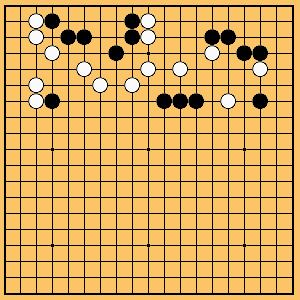
Problem B: Go
Go is played on a square board with an odd number of
vertical and horizontal lines. The usual board
sizes are 9x9, 13x13 and 19x19. But we'll assume
the size in nxn for 3 ≤ n ≤ 19.
Black and White alternately play stones on the
intersection between two lines. Black starts. At
any time one player may pass - not play a stone -
but if both players pass the game ends. We'll
denote playing a stone by P(x,y) where P is either
B (for Black) or W (for White) and (1-n)/2 ≤ x,y &le (n-1)/2
gives the grid position of the stone to be played.
The centre intersection of the board has coordinates (0,0).
The rules of Go are reasonably straightforward, but the
nuances of strategy make it an extremely challenging game.
You are to use the following rules.
- Black plays first.
- Black and White alternate; at each turn a player may place
a stone or may pass. The game ends when Black and White pass
consecutively.
- A stone may be played only on an unoccupied intersection.
- If one player P places a stone so that his or her stones
(along with the edge of the board) completely surround a
connected area occupied by stones belonging to the other
player, Q, Q's stones are said to be captured and removed
from the board. More precisely, two intersections are
connected if they are horizontally or vertically
(but not diagonally) adjacent. Stones in an area
are completely surrounded if no stone is
connected with a vacant intersection.
- If P places a stone that causes
Q's stones to be captured, P's stone is
not captured.
- A connected area surrounded by P's stones which
contains none of Q's stones is said to be owned
by P.
- The score for player P is the number of
vacant intersections owned by P in the final board
configuration plus the number of Q's stones captured by P
at any time during the game.
The input consists of several test cases. Each
test case begins with a line containing n
- the size of the board - and m - the
number of stones placed in the game. m lines
follow, each giving a placement in the format above.
Note that m counts only stone placements -
passes may result in two consecutive placements
by the same player.
You may assume that each move is legal.
A line
containing 0 0 follows the last test case.
For each test case, output a line with two
numbers: Black's score followed by White's score.
Sample Input
7 6
B(-2,-2)
W(2,2)
B(-2,-3)
W(2,3)
B(-3,-2)
W(3,2)
7 6
B(-2,-3)
W(-3,-3)
B(-2,-2)
W(3,2)
B(-3,-2)
W(2,3)
0 0
Output for Sample Input
1 1
2 1
Gordon V. Cormack

This work is licensed under a Creative Commons Attribution-ShareAlike 3.0 Unported License.

